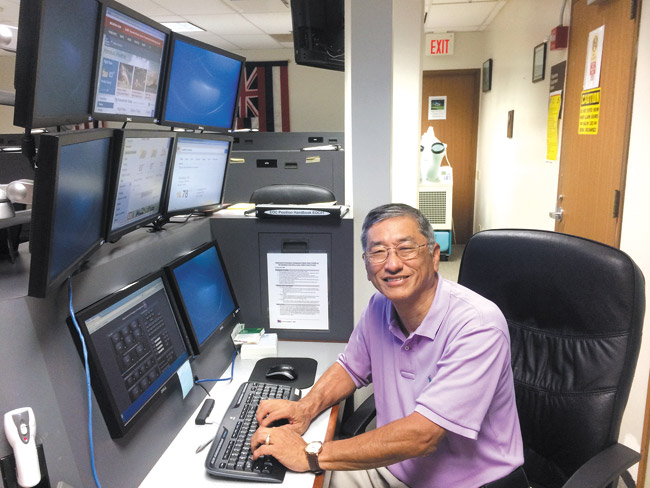Hurricane Season Emergency Plans

The first director of the city Department of Emergency Management, Mel Kaku | Photo courtesy Nicole Magliano
It’s hurricane season again and time to put plans in place in the event that disaster is at your doorstep. Who can forget Sept. 11, 1991, when Hurricane Iniki made landfall with 145 mph winds, and was recorded as the most powerful hurricane ever to hit Hawaii? Kauai suffered horrifically from raging, 35-foot waves that ravaged the beautiful Garden Isle and wreaked havoc on the lives of some 5,000 people.
The months and years to follow were just as painful dealing with the devastation and rebuilding efforts. I recall visiting Kauai as the state DBEDT director when Gov. John Waihee tasked our department with taking the lead in evacuating the thousands of stranded tourists.
Kauai looked like a war zone in Iniki’s aftermath, but what people have imprinted in their minds almost 23 years later is not so much the astronomical damage or pain and suffering, but rather the overwhelming outpouring of support and love that followed. Organizations, churches and individuals from all over the world focused on giving radiant hope to Kauai’s citizens.
Waipahu resident Ambrose Velasco understands that natural disasters like Iniki can strike in the blink of an eye. For that reason, he has stashed away two years of food and emergency supplies.
“Hawaii is susceptible to year-round conditions via tropical storms and hurricanes — so many opportunities for life-threatening natural disasters to occur. Having survived combat and served in the Army for 20 years, I have lived my life being prepared at all times,” says Velasco.
The decorated veteran’s storage consists of 10 cases of freeze-dried hamburger, buckets of vegetables, shelves of canned fruits and other nonperishable goods. He also has two years’ worth of water and MREs, including two 24-watt generators that run on gasoline and propane. Velasco recycles his batteries and updates his plans constantly.
Like Velasco, the state of Hawaii, civil defense agencies and emergency management organizations across all county levels are also updating their emergency plans. The state and four county mayors will be granted unprecedented emergency powers during a crisis, including a terrorist attack. The move stems from a House bill sponsored by Speaker Joseph Souki and shepherded by state Adjutant General Maj. Gen. Darryll D. M. Wong, who also serves as the state’s director of civil defense. HB 849 recodifies Hawaii’s emergency management statutes, “clarifying the relationship between the state and county emergency management agencies, and delineating the emergency management functions and powers of the Governor and mayors.” Currently awaiting the governor’s signature, the bill — expected to be law in July — will rename the state Civil Defense Agency “Hawaii Emergency Management Agency,” which will be housed under the state Department of Defense. “The new law will be a significant milestone because it brings Hawaii’s emergency-management systems to current national codes instead of being in the Cold War era,” said director of the city Department of Emergency Management (DEM), Mel Kaku.
“All counties have updated their hurricane plans and are rewriting internal procedures, working closely with state government to develop the various responses and logistic support plans. For example, we are partnering with the state on the installation of additional sirens on Oahu,” Kaku says.
The sirens wish list is at 80-plus, to be installed throughout Oahu, but the current state budget covers all islands with as much as $12 million earmarked. Each siren costs approximately $84,000, according to Kaku.
I am pleased to see the upgrades, as well as the improved working relationship among Department of Homeland Security, federal government and state and local governments. This was a push that we started back in 2007 during my first term as mayor. Back then, emergency operations were under the purview of the Oahu Civil Defense Agency (OCDA). We elevated the agency to the current cabinet-level DEM, making Kaku its first director. In so doing, Kaku was given the same status as other first-responder heads, such as the Honolulu police and fire chiefs. As part of the elevation to department status, DEM also was given more tools to communicate information directly and quickly to the public, especially if a natural disaster threatened Oahu. We were totally committed to the city’s preparedness efforts, and alerting the general public in a timely manner during emergencies was our utmost concern.
With the new emergency management changes to come, the next time a natural disaster strikes, our city and state hopefully will be better prepared to respond and serve the residents and visitors of Hawaii.
As for the forecast of hurricanes in Hawaii this year, Central Pacific Hurricane Center (CPHC) announced last month that the climate conditions point to a 40 percent chance of a near-normal or above-normal season. I prescribe to the old adage that says, “It’s not if a disaster will strike — but when.”
mufi@mufihannemann.com





